Thin Layers of Cerium Oxynitride Deposited via RF Sputtering
Abstract
1. Introduction
2. Materials and Methods
2.1. Substrate Preparation and Deposition Conditions
- Co-sputtering: Employing INTERCOVAMEX H2 equipment (Episerve, Munich, Germany) with a zirconium target and a 2-inch diameter-, 5 mm thick-cerium target (99.95% purity, Stanford Advanced Materials). The target–substrate distance remained constant at 10 cm, deposition temperature was 200 °C, with a power applied to the target at 150 W. Ar and O2 flow rates were 20.0 sccm and 2.00 sccm, respectively, with a nitrogen flow rate varying between 15.0 sccm and 40.0 sccm. Deposition time was 45 min and the working pressure was maintained at 6.7 × 10−1 Pa.
- Radiofrequency (RF) sputtering: Utilizing Alcatel HS 2000 (Alcatel Vacuum Technology, Annecy, France) equipment with a 13.8 MHz RF source. The targets used were high-purity Ce and Zr (99.95%), with a 2-inch and 4-inch diameter, respectively, and 5 mm thickness (Stanford Advanced Materials). Ar and O2 fluxes were 20.0 sccm and 2.00 sccm, respectively, and N2 flux varied between 15.0 and 40.0 sccm. The substrate target distance was kept constant at 5 cm, and the substrate temperature at 200 °C. Deposition time was 45 min, with a power applied to the target of 150 W, and the working pressure was constant at 1.4 × 10−1 Pa. To ensure coating adhesion to the substrate, a NiZrO2 buffer layer was deposited for 15 min at a power of 250 W and an Ar flow rate of 20 sccm. The target configuration used is presented in Figure 1, and the deposition conditions for each method are summarized in Table 1.
2.2. Characterization of the Coatings
2.3. Corrosion Resistance
3. Results and Discussion
3.1. Co-Sputtering
- Zr4+ induces oxygen vacancies in the crystal structure of CeOxNy;
- Ce4+ undergoes reduction to Ce3+ within the oxygen vacancies;
- The formation of stable Ce(III) complexes with the OH− of the medium inhibits the corrosion process.
3.2. RF Sputtering
3.2.1. Chemical Composition
3.2.2. Chemical Structure
3.2.3. Corrosion Test
4. Conclusions
Author Contributions
Funding
Institutional Review Board Statement
Informed Consent Statement
Data Availability Statement
Acknowledgments
Conflicts of Interest
References
- da Silva Oliveira, C.I.; Martinez-Martinez, D.; Cunha, L.; Rodríguez, M.S.; Borges, J.; Lopes, C.; Apreutesei, M. Zr-ON coatings for decorative purposes: Study of the system stability by exploration of the deposition parameter space. Surf. Coat. Technol. 2018, 343, 30–37. [Google Scholar] [CrossRef]
- Shi, Z.; Zhifeng, Z.; Shum, P.; Li, L.K.Y. Thermal stability, wettability and corrosion resistance of sputtered ceria films on 316 stainless steel. Appl. Surf. Sci. 2019, 477, 166–171. [Google Scholar] [CrossRef]
- Wu, K.H.; Jiang, Y.; Jiao, S.Q.; Chou, K.C.; Zhang, G.H. Preparations of titanium nitride, titanium carbonitride and titanium carbide via a two-step carbothermic reduction method. J. Solid State Chem. 2019, 277, 793–803. [Google Scholar] [CrossRef]
- Ul-Hamid, A. Microstructure, properties and applications of Zr-carbide, Zr-nitride and Zr-carbonitride coatings: A review. Mater. Adv. 2020, 1, 1012–1037. [Google Scholar] [CrossRef]
- Zhang, Y.W.; Li, S.J.; Lin, B.X.; Yan, C.H. Urea-based hydrothermally derived homogeneous nanostructured Ce1−xZrxO2 (x = 0–0.8) sold solutions: A strong correlation between oxygen storage capacity and lattice strain. J. Phys. Chem. B 2004, 108, 12481–12488. [Google Scholar]
- Rajeshkumar, S.; Naik, P. Synthesis and biomedical applications of Cerium oxide nanoparticles. Biotechnol. Rep. 2018, 17, 1–5. [Google Scholar] [CrossRef]
- Wei, J.; Fan, C.; Zhuang, Y.; Fu, Z.; Guan, Z.; Li, H.; Li, D.; Qian, Y. Diesel soot combustion over ceria catalyst: Evolution of functional groups on soot surfaces. Fuel 2023, 338, 127391. [Google Scholar] [CrossRef]
- Bai, D.; Meng, J.P.; Zou, C.; Li, C.; Liang, C.H. Manipulation of hydroisomerization performance on Pt/ZSM-23 by introducing Al2O3. J. Fuel Chem. Technol. 2023, 51, 175–185. [Google Scholar] [CrossRef]
- Kozhukhova, A.E.; du Preez, S.P.; Bessarabov, D.G. Development of PtCo/Al2O3 bimetallic catalyst and its evaluation in catalytic hydrogen combustion reaction. Int. J. Hydrog. Energy 2024, 51, 1079–1096. [Google Scholar] [CrossRef]
- Cai, X.; Seal, S.; McGinnis, J.F. Cerium oxide nanoparticle reduction of oxidative damage in Retina. In Studies on Retinal and Choroidal Disorders, Oxidative Stress in Applied Basic Research and Clinical Practice; Stratton, R., Hauswirth, W., Gardner, T., Eds.; Humana Press: Totowa, NJ, USA, 2012; pp. 399–418. [Google Scholar]
- Suresh, A.; Mayo, M.J.; Porter, W.D.; Rawn, C.J. Crystallite and grain-size-dependent phase transformations in yttria-doped zirconia. J. Am. Ceram. Soc. 2003, 8, 360–362. [Google Scholar] [CrossRef]
- Arenas, F.; Ponce de León, C.; Walsh, F.C. Electrochemical redox processes involving soluble cerium species. Electrochim. Acta 2016, 205, 226–247. [Google Scholar] [CrossRef]
- Castano, C.E.; O’Keefe, M.J.; Fahrenholtz, W.G. Cerium-based oxide coatings. Curr. Opin. Solid State Mater. Sci. 2015, 19, 69–76. [Google Scholar] [CrossRef]
- Kim, T.; Kim, H.J.; Go, D.; Shin, J.W.; Yang, B.C.; Cho, G.Y.; Gur, T.M.; An, J. Reactive sputtered Ni-SDC cermet alloy anode for low-temperature solid oxide fuel cell. J. Alloys Compd. 2022, 924, 166332. [Google Scholar] [CrossRef]
- Yu, J.G.; Yang, B.C.; Shin, J.W.; Lee, S.; Oh, S.; Choi, J.H.; Jeong, J.; Noh, W.; An, J. High growth-rate atomic layer deposition process of cerium oxide thin film for solid oxide fuel cell. Ceram. Int. 2019, 45, 3811–3815. [Google Scholar] [CrossRef]
- Joseph, A.; Thomas, T. Recent advances and prospects of metal oxynitrides for supercapacitor. Prog. Solid State Chem. 2022, 68, 100381. [Google Scholar] [CrossRef]
- Kaliaraj, G.S.; Kumar, N. Oxynitrides decorated 316L SS for potential bioimplant application. Mater. Res. Express 2018, 5, 036403. [Google Scholar] [CrossRef]
- Wang, X.Z.; Muneshwar, T.P.; Fan, H.Q.; Cadien, K.; Luo, J.L. Achieving ultrahigh corrosion resistance and conductive zirconium oxynitride coating on metal bipolar plates by plasma enhanced atomic layer deposition. J. Power Sources 2018, 397, 32–36. [Google Scholar] [CrossRef]
- da Silva Oliveira, C.I.; Martinez-Martinez, D.; Al-Rjoub, A.; Rebouta, L.; Menezes, R.; Cunha, L. Development of a statistical method to help evaluating the transparency/opacity of decorative thin films. Appl. Surf. Sci. 2018, 438, 51–58. [Google Scholar] [CrossRef]
- Cristea, D.; Scărlătescu, A.I.; Croitoru, C.; Marin, A.; Velicu, I.L.; Tiron, V.; Martínez-Martínez, D.; da Silva Oliveira, C.I.; Cunha, L. Photocatalytical and corrosion behavior of sputtered zirconium oxynitride thin films doped with titanium. Surf. Interfaces 2023, 42, 103488. [Google Scholar] [CrossRef]
- Nagaraju, P.; VijayaKumar, Y.; Radhika, P.; Choudhary, R.J.; Ramanam, M.V. Structural, morphological, optical and gas sensing properties of nanocrystalline ceria thin films. Mater. Today Proc. 2016, 3, 4009–4018. [Google Scholar] [CrossRef]
- Nagaraju, P.; Vijayakumar, Y.; Choudhary, R.J.; Reddy, M.R. Preparation and characterization of nanostructured Gd doped cerium oxide thin films by pulsed laser deposition for acetone sensor application. Mater. Sci. Eng. B 2017, 226, 99–106. [Google Scholar] [CrossRef]
- Hao, Y.; Yang, C.K.; Haile, S.M. Ceria–Zirconia Solid Solutions (Ce1–xZrxO2−δ, x ≤ 0.2) for Solar Thermochemical Water Splitting: A Thermodynamic Study. Chem. Mater. 2014, 26, 6073–6082. [Google Scholar] [CrossRef]
- Her, J.L.; Bag, S.P.; Garu, P.; Lou, B.S.; Pan, T.M. Super Nernstian pH sensitivity of excess cerium in Ce2-xSrx(Zr0.53Ti0.47)Oy sensing membranes for solid state pH sensors. Sens. Actuators B Chem. 2018, 274, 133–143. [Google Scholar] [CrossRef]
- Simonenko, T.L.; Simonenko, N.P.; Mokrushin, A.S.; Simonenko, E.P.; Glumov, O.V.; Mel’nikova, N.A.; Murin, I.V.; Kalinina, M.V.; Shilova, O.A.; Sevastyanov, V.G.; et al. Microstructural, electrophysical and gas-sensing properties of CeO2–Y2O3 thin films obtained by the sol-gel process. Ceram. Int. 2020, 46, 121–131. [Google Scholar] [CrossRef]
- Aneggi, E.; Campagnolo, F.; Segato, J.; Zuccaccia, D.; Baratta, W.; Llorca, J.; Trovarelli, A. Solvent-free selective oxidation of benzyl alcohol using Ru loaded ceria-zirconia catalysts. Mol. Catal. 2023, 540, 113049. [Google Scholar] [CrossRef]
- Chaudhary, M.L.; Al-Fatesh, A.S.; Kumar, R.; Lanre, M.S.; Frusteri, F.; AlReshaidan, S.B.; Ibrahim, A.A.; Abasaeed, A.E.; Fakeeha, A.H. Promotional effect of addition of ceria over yttria zirconia supported Ni based catalyst system for hydrogen production through dry reforming of methane. Int. J. Hydrog. Energy 2022, 47, 20838–20850. [Google Scholar] [CrossRef]
- Wang, J.; Lai, X.; Zhang, H.; Zhou, X.; Lin, T.; Wang, J.; Chen, Y. Low-temperature toluene oxidation on Ag/CexZr1-xO2 monolithic catalysts: Synergistic catalysis of silver and ceria-zirconia. Combust. Flame 2023, 248, 112577. [Google Scholar] [CrossRef]
- Somacescua, S.; Cioatera, N.; Osiceanu, P.; Calderon-Moreno, J.M.; Ghica, C.; Neaţu, F.; Flores, M. Bimodal mesoporous NiO/CeO2-δ-YSZ with enhanced carbon tolerance in catalytic partial oxidation of methane potential IT-SOFCs anode. Appl. Catal. B Environ. 2019, 241, 393–406. [Google Scholar] [CrossRef]
- Suboti, B.S.V.; Preininger MSchwaiger, M.; Evic, N.; Schroettner, H.; Hochenauer, C. Characterization and performance evaluation of ammonia as fuel for solid oxide fuel cells with Ni/YSZ anodes. Electrochim. Acta 2019, 298, 874–883. [Google Scholar]
- Chamani, S.; Mobasheri, L.; Rostami, Z.; Zare, I.; Naghizadeh, A.; Mostafavi, E. Heavy metals in contact dermatitis: A review. J. Trace Elem. Med. Biol. 2023, 79, 127240. [Google Scholar] [CrossRef]
- Manam, N.S.; Harun, W.S.W.; Shri, D.N.A.; Ghani, S.A.C.; Kurniawan, T.; Ismail, M.H.; Ibrahim, M.H.I. Study of corrosion in biocompatible metals for implants: A review. J. Alloys Compd. 2017, 701, 698–715. [Google Scholar] [CrossRef]
- Cubillos, G.I.; Olaya, J.J.; Clavijo, D.; Alfonso, J.E.; Cardozo, C. Synthesis and biological characterization of zirconium oxynitride thin film growth by radio-frequency sputtering. Thin Solid Films 2013, 529, 342–346. [Google Scholar] [CrossRef]
- Buchananand, R.A.; Stansbury, E.E. Electrochemical Corrosion. In Handbook of Environmental Degradation of Materials, 2nd ed.; Kutz, M., Ed.; Elsevier: Amsterdam, The Netherlands, 2013; pp. 87–125. [Google Scholar]
- Zhang, L.M.; Zhang, S.D.; Ma, A.L.; Umoh, A.J.; Hu, H.X.; Zheng, Y.G.; Yang, B.J.; Wang, J.Q. Influence of cerium content on the corrosion behavior of Al-Co-Ce amorphous alloys in 0.6 M NaCl solution. J. Mater. Sci. Technol. 2019, 35, 1378–1387. [Google Scholar] [CrossRef]
- Calado, L.M.; Taryba, M.G.; Carmezim, M.J.; Montemor, M.F. Self-healing ceria-modified coating for corrosion protection of AZ31 magnesium alloy. Corros. Sci. 2018, 142, 12–21. [Google Scholar] [CrossRef]
- Montemor, M.F.; Ferreira, M.G.S. Cerium salt activated nanoparticles as fillers for silane films: Evaluation of the corrosion inhibition performance on galvanised steel substrate. Electrochim. Acta 2007, 52, 6976–6987. [Google Scholar] [CrossRef]
- Wang, Q.; Yue, M.; Zhong, Q.; Cui, M.; Huang, X.; Hou, Y.; Wang, L.; Yang, Y.; Long, Z.; Feng, Z. Structure and properties of cerium zirconium mixed oxide prepared under different precipitate aging processes. J. Rare Earths 2016, 34, 695–703. [Google Scholar] [CrossRef]
- Pan, M.T.; Wang, C.W.; Chen, C.Y. Structural properties and sensing performance of CeYxOy sensing films for electrolyte insulator semiconductor pH sensors. Sci. Rep. 2017, 7, 2945. [Google Scholar] [CrossRef] [PubMed]
- Abellan, P.; Moser, T.H.; Lucas, I.T.; Grate, J.W.; Evans, J.E.; Browning, N.D. The formation of cerium (III) hydroxide nanoparticles by a radiation mediated increase in local pH. RSC Adv. 2017, 7, 3831–3837. [Google Scholar] [CrossRef]
- Humphreys, J.; Lan, R.; Chen, S.; Walker, M.; Han, Y.; Tao, S. Cation doped cerium oxynitride with anion vacancies for Fe-based catalyst with improved activity and oxygenate tolerance for efficient synthesis of ammonia. Appl. Catal. B Environ. 2021, 285, 119843. [Google Scholar] [CrossRef]
- Channei, D.; Phanichphant, S.; Nakaruk, A.; Mofarah, S.S.; Koshy, P.; Sorrell, C.C. Aqueous and surface chemistries of photocatalytic Fe-Doped CeO2 nanoparticles. Catalysts 2017, 7, 45. [Google Scholar] [CrossRef]
- Vangelista, S.; Piagge, R.; Ek, S.; Sarnet, T.; Ghidini, G.; Martella, C.; Lamperti, A. Structural, chemical and optical properties of cerium dioxide film prepared by atomic layer deposition on TiN and Si substrates. Thin Solid Films 2017, 636, 78–84. [Google Scholar] [CrossRef]
- Phokhaa, S.; Limwichean, S.; Horprathum, M.; Patthanasettakul, V.; Chananonnawathorn, C.; Eiamchai, P.; Chanlek, N.; Maensiri, S. Effect of annealing temperature on the structural and magnetic properties of CeO2 thin films. Thin Solid Film 2020, 204, 138001. [Google Scholar] [CrossRef]
- Zanfoni, N.; Avril, L.; Imhoff, L.; Domenichini, D.; Bourgeois, S. Direct liquid injection chemical vapor deposition of platinum doped cerium oxide thin films. Thin Solid Films 2015, 589, 246–251. [Google Scholar] [CrossRef]
- Li, S.; Zhang, Y.; Li, X.; Yang, X.; Li, Z.; Wang, R.; Zhu, H. Preferential oxidation of CO in H2-rich stream over Au/CeO2–NiO catalysts: Effect of the preparation method. Catal. Lett. 2018, 148, 328–340. [Google Scholar] [CrossRef]
- Rakhmatullin, A.; Boča, M.; Mlynáriková, J.; Hadzimová, E.; Vasková, Z.; Polovov, I.B.; Mičušík, M. Solid state NMR and XPS of ternary fluorido-zirconates of various coordination modes. J. Fluor. Chem. 2018, 208, 24–35. [Google Scholar] [CrossRef]
- Kapoor, M.P.; Ichihashi, Y.; Shen, W.J.; Matsumura, Y. Catalytic activity of palladium supported on mesoporous zirconium oxide in low-temperature methanol decomposition. Catal. Lett. 2017, 6, 139–142. [Google Scholar]
- Jia, Y.; Li, H.; Hu, N.; Wang, Q. Enhanced visible light adsorption of heavily nitrogen doped CeO2 thin film via ion beam assisted deposition. Rare Met. Mat. Eng. 2016, 45, 1988–1991. [Google Scholar]
- Rizzo, A.; Signore, M.A.; Mirenghi, L.; Tapfer, L.; Piscopiello, E.; Salernitano, E.; Giorgi, R. Sputtering deposition and characterization of zirconium nitride and oxynitride films. Thin Solid Films 2012, 520, 3532–3538. [Google Scholar] [CrossRef]
- Trentin, A.; Harb, S.V.; Uvida, M.C.; Marcoen, K.; Pulcinelli, S.H.; Santilli, C.V.; Terryn, H.; Hauffman, T.; Hammer, P. Effect of Ce(III) and Ce(IV) ions on the structure and active protection of PMMA-silica coatings on AA7075 alloy. Corros. Sci. 2021, 189, 109581. [Google Scholar] [CrossRef]
- Ershov, S.; Druart, M.E.; Poelman, M.; Cossement, D.; Snyders, R.; Olivier, M.G. Deposition of cerium oxide thin films by reactive magnetron sputtering for the development of corrosion protective coatings. Corros. Sci. 2013, 75, 158–168. [Google Scholar] [CrossRef]
- Qiao, Z.; Mergel, D. Comparison of radio-frequency and direct-current magnetron sputtered thin In2O3:Sn films. Thin Solid Films 2005, 484, 146–153. [Google Scholar] [CrossRef]
- Timoshnev, S.; Kazakin, A.; Shubina, K.; Andreeva, V.; Fedorenko, E.; Koroleva, A.; Zhizhin, E.; Koval, O.; Kurinnaya, A.; Shalin, A.; et al. Annealing Temperature Effect on the Physical Properties of NiO Thin Films Grown by DC Magnetron Sputtering. Adv. Mater. Interfaces 2024, 11, 2300815. [Google Scholar] [CrossRef]
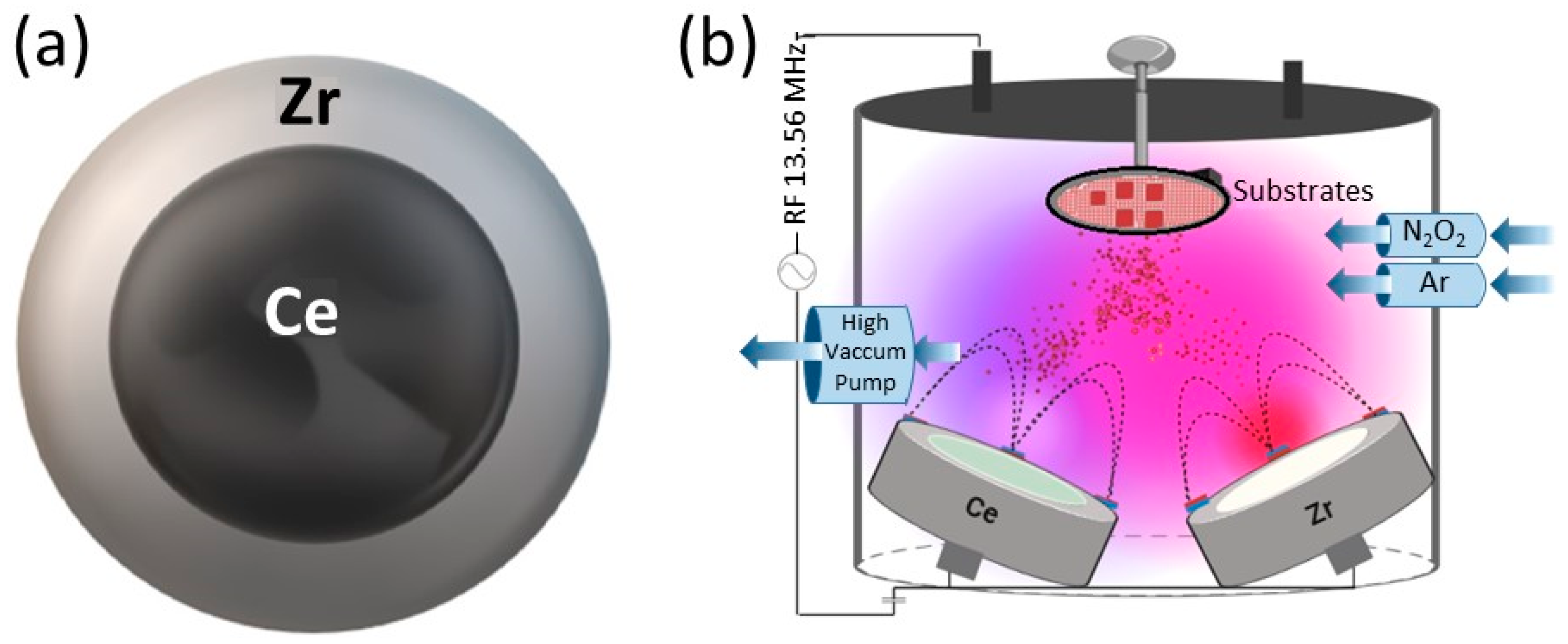
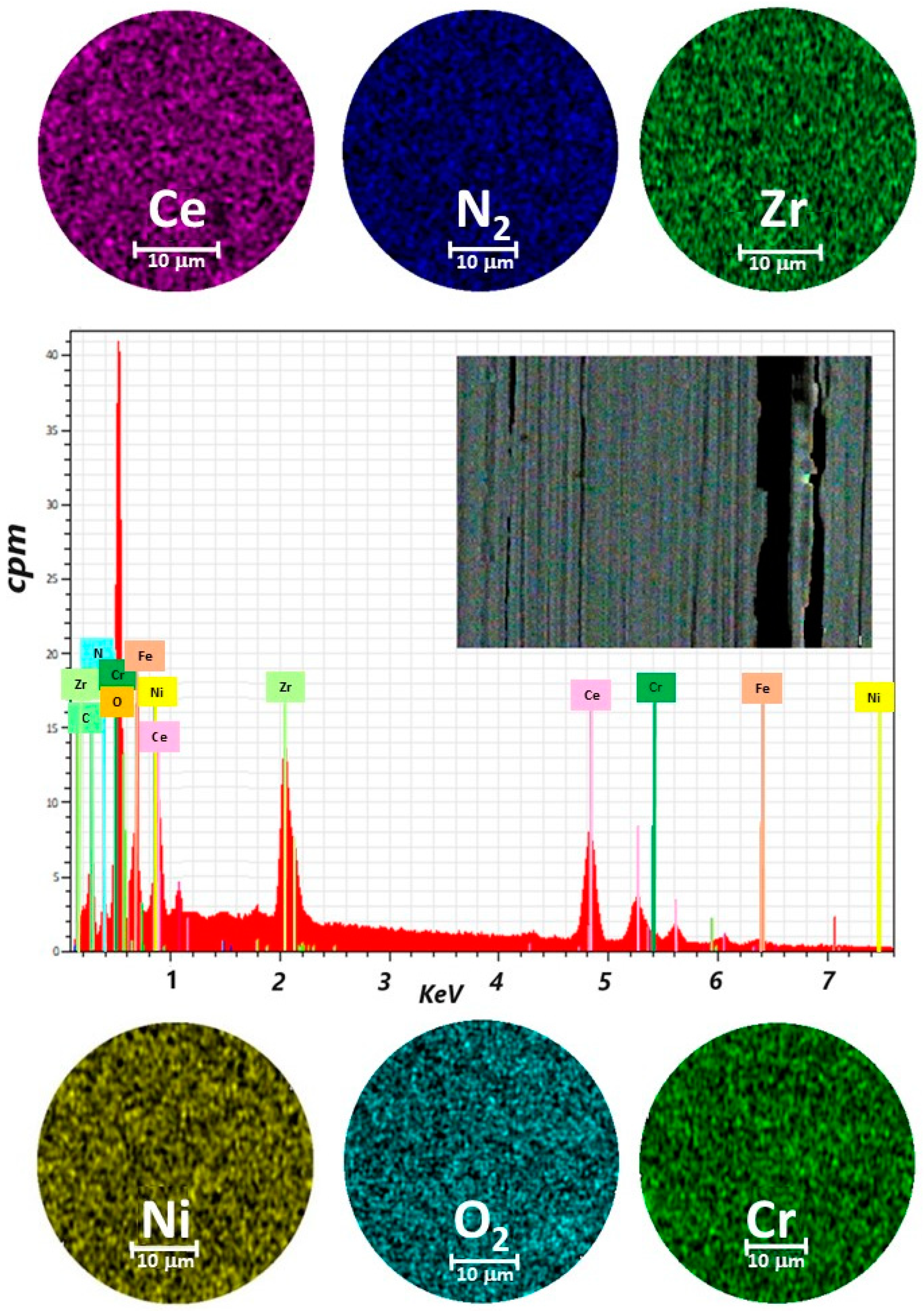
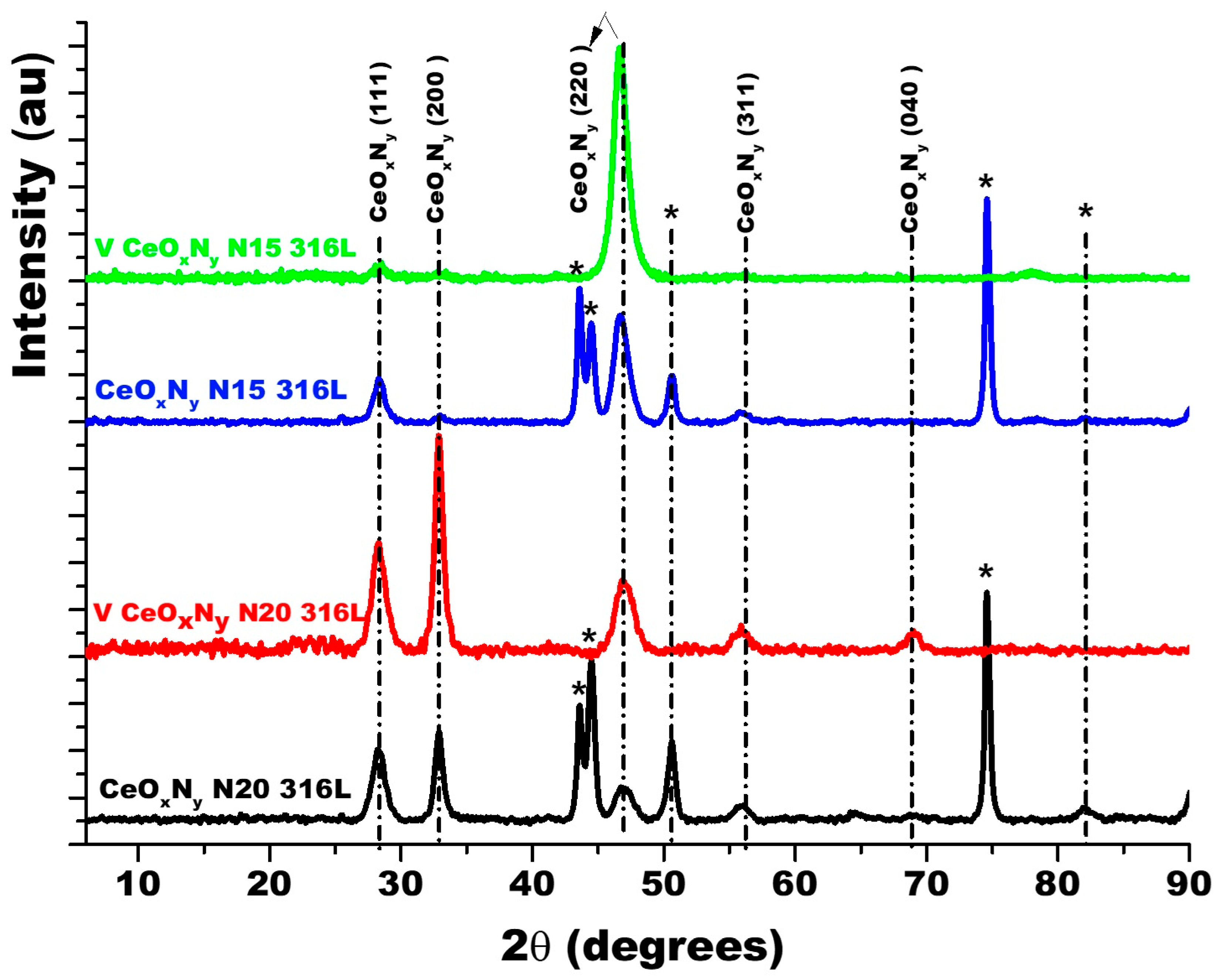

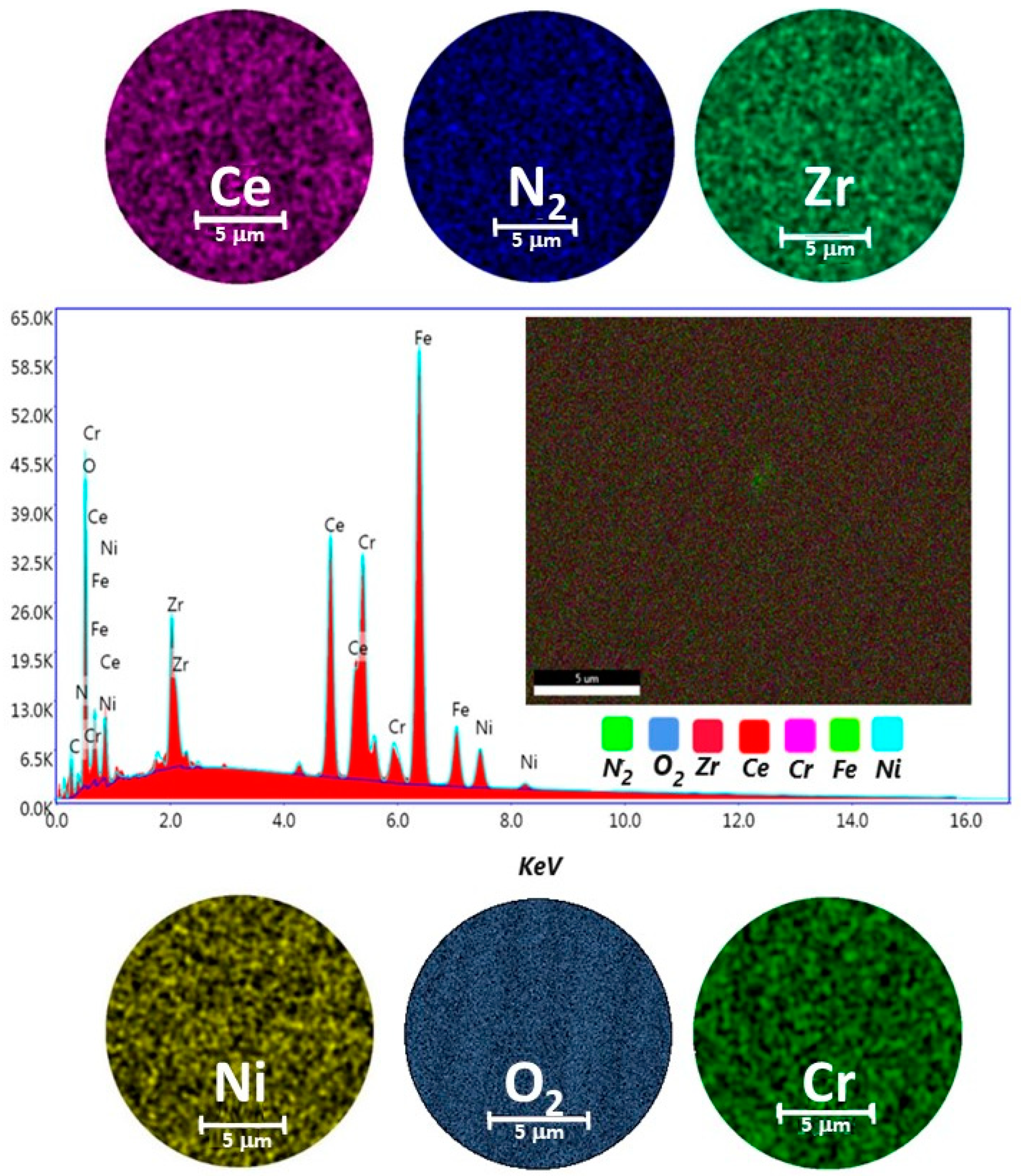
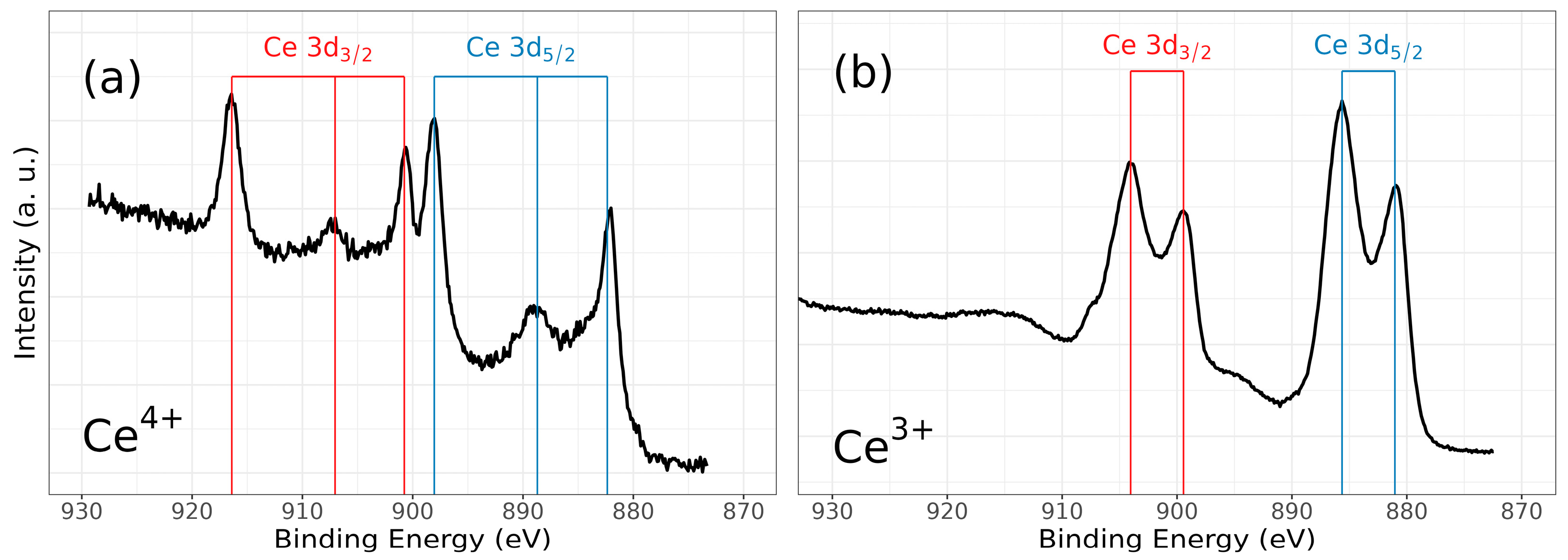
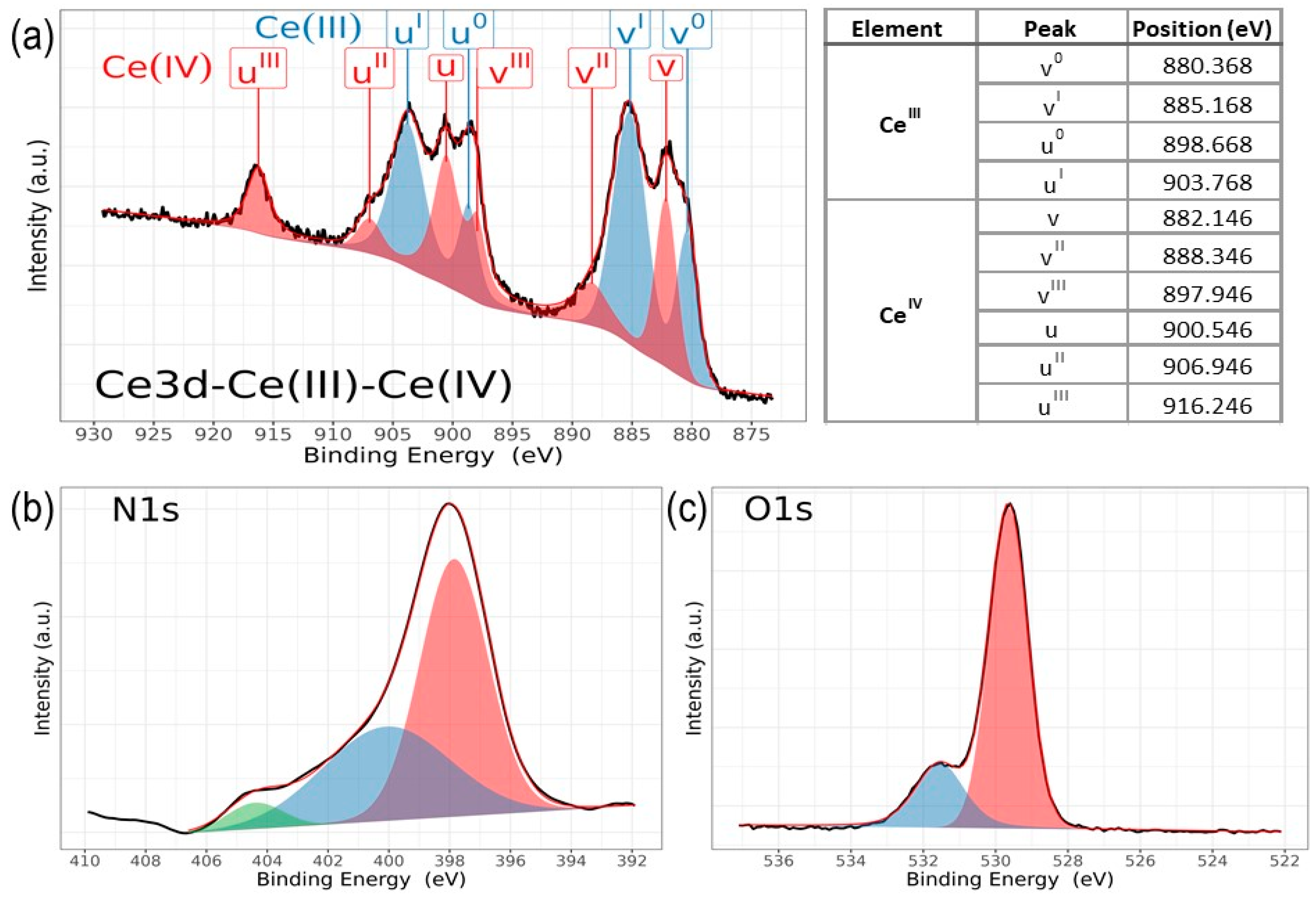
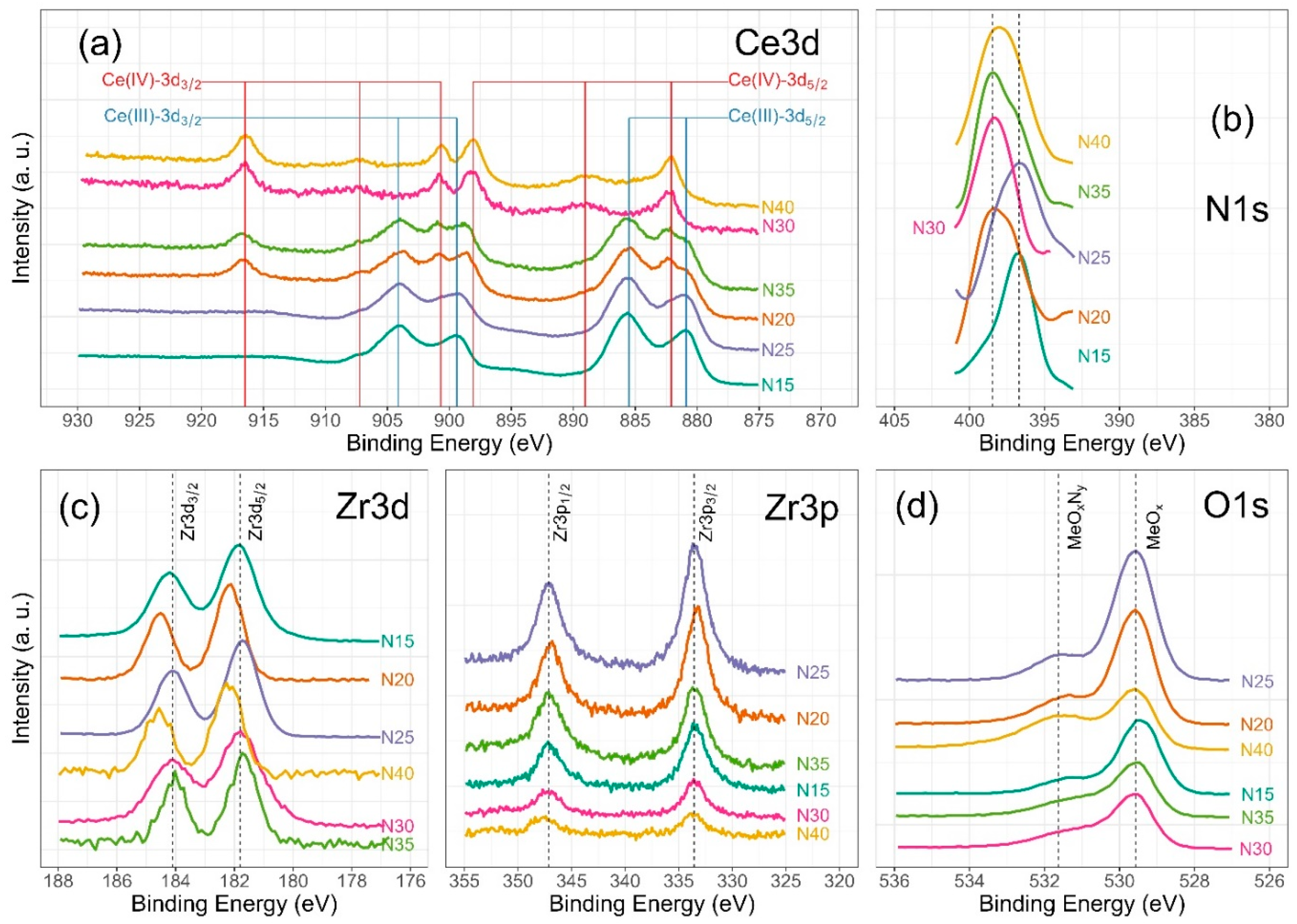






| Coatings | Power (W) | T (°C) | ϕAr (sccm) | ϕO2 (sccm) | ϕN2 (sccm) |
|---|---|---|---|---|---|
| ZrCeOxNy RF sputtering | 150, 200, 250, 300, 350 | 200, 220, 300 | 20.0 | 1.00 | 15.0–40.0 |
| 1.50 | |||||
| 2.00 | |||||
| ZrCeOxNy Co-sputtering | 100, 150, 200 | 150, 200, 200 | 20.0 | 1.00 | 15.0–40.0 |
| 1.50 | |||||
| 2.00 |
| Compound | NaCl | CaCl2·2H2O | KCl | MgCl2·6H2O | NaH2PO4 | KH2PO4 | MgSO4·7H2O | NaHCO3 | C6H12O6 |
|---|---|---|---|---|---|---|---|---|---|
| Concentration (g/L) | 8.00 | 0.140 | 0.400 | 0.100 | 6.00 × 10−2 | 6.00 × 10−2 | 6.00 × 10−2 | 0.450 | 1.00 |
| Sample | ϕN2 (sccm) | Jcorr (A/cm2) | Ecorr (V) | Rp (Ohm/cm2) | Vcorr (mmpy) | Enp (V) |
|---|---|---|---|---|---|---|
| AISI 316L | 6.75 × 10−8 | −7.80 × 10−2 | 3.85 × 105 | 7.84 × 10−4 | 5.87 × 10−2 | |
| ZrCeOxNy N15 | 15.0 | 8.16 × 10−10 | 2.34 × 10−1 | 3.19 × 107 | 9.49 × 10−6 | 6.49 × 10−1 |
| ZrCeOxNy N20 | 20.0 | 8.38 × 10−9 | 2.83 × 10−1 | 3.10 × 106 | 9.74 × 10−5 | 6.44 × 10−1 |
| (a) | ||||||
|---|---|---|---|---|---|---|
| Element | Weight % | |||||
| Zr-CeOxNy N15 | Zr-CeOxNy N20 | Zr-CeOxNy N25 | Zr-CeOxNy N30 | Zr-CeOxNy N35 | Zr-CeOxNy N40 | |
| N (K) | 1.12 | 0.802 | 1.17 | 0.820 | 0.65 | 0.601 |
| O (K) | 11.5 | 11.6 | 10.6 | 8.05 | 10.4 | 9.30 |
| Zr (L) | 5.87 | 7.86 | 4.28 | 4.24 | 6.00 | 3.76 |
| Ce (L) | 15.9 | 24.8 | 17.7 | 16.5 | 13.6 | 16.9 |
| Cr (K) | 11.8 | 17.3 | 14.6 | 7.6 | 12.6 | 12.1 |
| Fe (K) | 38.2 | 25.3 | 40.6 | 54.2 | 41.2 | 42.7 |
| Ni (K) | 8.96 | 4.55 | 5.66 | 4.65 | 9.06 | 5.95 |
| (b) | ||||||
| Element | Weight % | |||||
| Zr-CeOxNy N15 | Zr-CeOxNy N20 | Zr-CeOxNy N25 | Zr-CeOxNy N30 | Zr-CeOxNy N35 | Zr-CeOxNy N40 | |
| N (K) | 4.10 | 2.90 | 5.05 | 3.80 | 3.21 | 2.83 |
| Zr (K) | 25.5 | 26.1 | 18.5 | 19.6 | 29.7 | 17.7 |
| Ce (L) | 70.4 | 71.0 | 76.5 | 76.6 | 67.1 | 79.5 |
| 2θ | h k l | CeO2 | ZrCeOxNy | Δθ |
|---|---|---|---|---|
| 1 | 1 1 1 | 28.8 | 27.7 | 1.1 |
| 2 | 2 0 0 | 33.3 | 32.8 | 0.45 |
| 3 | 2 2 0 | 47.6 | 46.8 | 0.83 |
| Sample | ϕN2 sccm | Jcorr nA/cm2 | Ecorr V | Rp MΏ/cm2 | Vcorr mmpy10−6 | Enp V | PZx 10−1 |
|---|---|---|---|---|---|---|---|
| AISI 316L | NA | 67.5 ± 6.8 | −0.174 ± 4.3 × 10−2 | 0.385 ± 0.11 | 784 ± 68 | 0.204 ± 3.8 × 10−2 | 3.78 |
| ZrCeOxNy N15 | 15.0 | 0.412 ± 0.12 | −9.60 × 10−2 ± 8 × 10−3 | 63.1 ± 17 | 1.89 ± 0.37 | 1.13 ± 0.27 | 12.3 |
| ZrCeOxNy N20 | 20.0 | 0.453 ± 6.8 × 10−2 | 0.225 ± 4.0 × 10−2 | 57.4 ± 6.5 | 2.07 ± 0.34 | 0.644 ± 0.16 | 4.19 |
| ZrCeOxNy N25 | 25.0 | 0.210 ± 2.8 × 10−2 | 2.05 × 10−2 ± 9.4 × 10−3 | 129 ± 15 | 2.35 ± 0.34 | 0.777 ± 0.17 | 7.32 |
| ZrCeOxNy N30 | 30.0 | 0.206 ± 0.17 × 10−1 | 0.266 ± 2.0 × 10−2 | 12.6 ± 3.4 | 2.37 ± 0.20 | 0.790 ± 0.22 | 7.87 |
| ZrCeOxNy N35 | 35.0 | 0.539 ± 0.11 | 0.306 ± 6.0 × 10−2 | 48.3 ± 12 | 6.26 ± 1.6 | 0.960 ± 0.17 | 6.54 |
| ZrCeOxNy N40 | 40.0 | 0.450 ± 0.12 × 10−3 | 7.55 × 10−2 ± 5.1 × 10−3 | 57.8 ± 4.0 | 2.06 ± 1.5 × 10−1 | 0.409 ± 0.69 × 10−1 | 3.34 |
| ZrCeOxNy | N15 | N20 | N25 | N30 | N35 | N40 |
|---|---|---|---|---|---|---|
| Thickness (nm) | 615 ± 8.8 | 464 ± 16 | 526 ± 7.5 | 540 ± 17 | 506 ± 27 | 414 ± 6.2 |
Disclaimer/Publisher’s Note: The statements, opinions and data contained in all publications are solely those of the individual author(s) and contributor(s) and not of MDPI and/or the editor(s). MDPI and/or the editor(s) disclaim responsibility for any injury to people or property resulting from any ideas, methods, instructions or products referred to in the content. |
© 2024 by the authors. Licensee MDPI, Basel, Switzerland. This article is an open access article distributed under the terms and conditions of the Creative Commons Attribution (CC BY) license (https://creativecommons.org/licenses/by/4.0/).
Share and Cite
Numpaque, G.C.; Bethencourt, M.; Cubillos, G.I. Thin Layers of Cerium Oxynitride Deposited via RF Sputtering. Materials 2024, 17, 3142. https://doi.org/10.3390/ma17133142
Numpaque GC, Bethencourt M, Cubillos GI. Thin Layers of Cerium Oxynitride Deposited via RF Sputtering. Materials. 2024; 17(13):3142. https://doi.org/10.3390/ma17133142
Chicago/Turabian StyleNumpaque, Gloria Carolina, Manuel Bethencourt, and Gloria Ivonne Cubillos. 2024. "Thin Layers of Cerium Oxynitride Deposited via RF Sputtering" Materials 17, no. 13: 3142. https://doi.org/10.3390/ma17133142
APA StyleNumpaque, G. C., Bethencourt, M., & Cubillos, G. I. (2024). Thin Layers of Cerium Oxynitride Deposited via RF Sputtering. Materials, 17(13), 3142. https://doi.org/10.3390/ma17133142






